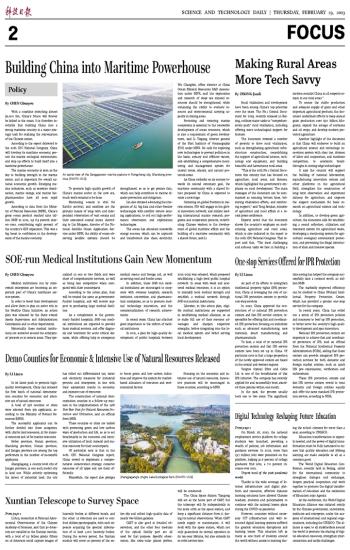
 Building China into Maritime Powerhouse
Building China into Maritime Powerhouse Making Rural Areas More Tech Savvy
Making Rural Areas More Tech Savvy 无标题
无标题 SOE-run Medical Institutions Gain New Momentum
SOE-run Medical Institutions Gain New Momentum One-stop Services Offered for IPR Protection
One-stop Services Offered for IPR Protection Demo Counties for Economic & Intensive Use of Natural Resources Released
Demo Counties for Economic & Intensive Use of Natural Resources Released 无标题
无标题 Digital Technology Reshaping Future Education
Digital Technology Reshaping Future Education Xuntian Telescope to Survey Space
Xuntian Telescope to Survey Space
Medical institutions run by state-owned enterprises are becoming an important part of China's healthcare service system.
In order to boost their development and allow them to play an active role in the Healthy China Initiative, an action plan was released by the State-owned Assets Supervision and Administration Commission and 12 other departments.
Historically, these medical institutions are scattered around the enterprises' projects or in remote areas. They specialized in one or two fields and were short of comprehensive services, as well as being less competitive when compared with their counterparts.
According to the action plan, they will be treated the same as government-funded hospitals, and will receive support in purchasing large medical facilities.
As a complement to the government-funded hospitals, SOE-run medical institutions are expected to provide basic medical services, and offer diagnosis and treatment for acute critical diseases, while offering help in emergency medical rescue and foreign aid, as well as serving rural and border areas.
In addition, these SOE-run medical institutions are encouraged to cooperate with overseas hospitals, research institutes, universities, and pharmaceutical enterprises, so as to promote medical technology innovation, and the commercialization of research achievements.
In recent years, China has attached great importance to the reform of medical institutions.
In 2021, a plan for high-quality development of public hospitals between 2021-2025 was released, which proposed establishing a high-level public hospital network. In areas with weak and scattered medical resources, it is an option to intensify local medical strength and establish a medical network through SOE-run medical institutions.
Likewise, in this action plan, eligible medical institutions are supported in establishing medical alliances, so as to make full use of their resource advantages and sharpen respective strengths, before integrating into the local medical system and better serving local development.


 Next
Next



